Parameter Optimization and Performance Research: Radial Inflow Turbine in Ocean Thermal Energy Conversion
Abstract
:1. Introduction
2. Materials and Methods
2.1. Turbine Aerodynamic Design
2.1.1. Circulation System Parameters Selection
2.1.2. Parameters Optimization and Design Results
2.2. Numerical Simulation of Radial Turbines
2.2.1. Three-Dimensional Modeling
2.2.2. Numerical Simulation Settings
2.2.3. Mesh Generation
2.3. Optimized Method of Radial Turbines—Data Regression Prediction Based on Support Vector Machine
3. Results
3.1. Numerical Simulation Results
3.2. Model Training and Optimization Results
3.3. Influence of Modeling Parameters on Turbine Performance
4. Discussion
4.1. Comparative Analysis of Optimization Scheme Performance
4.2. Performance Analysis of Variable Working Conditions
5. Conclusions
- (1)
- A 30 kW ocean thermal energy radial inflow turbine was designed, and a one-dimensional design optimization was performed using Isight 2020 and Matlab 2020b, obtaining the optimal scheme based on seven initial thermodynamic parameters, with a shaft efficiency of 86.228%. Based on the numerical simulation carried out using the CFX 2020 R2 software, this paper obtained radial inflow turbine models with different rotor shapes using parameterization and batch processing methods and analyzed their performance parameters.
- (2)
- Based on the one-dimensional optimal scheme, the rotor shape parameters were further optimized based on the support vector regression method, achieving the best adaptation of the rotor shape parameters, stator geometry parameters, and design condition. The regression prediction method used does not require a prior model and can directly obtain the nonlinear mapping relationship between the shape parameters and the shaft efficiency. The optimized rotor results are as follows: diameter ratio—0.421; blade number—16; twist angle—43.378°; radial clearance—2.553 mm; blade tip clearance—0.273 mm; blade thickness—1.582 mm; outlet blade fillet radius—3.152 mm.
- (3)
- The radial inflow turbine scheme obtained through using the model prediction method can effectively avoid the recirculation vortices on the suction surface of the moving rotor. The maximum shaft efficiency of the optimized scheme is 88.467%, which is 2.239% higher than that of the one-dimensional design optimal scheme, effectively improving the flow uniformity of the turbine and increasing its service life. This paper studied the influence of shape parameters on the shaft efficiency of the radial inflow turbine, revealing the coupling relationship between blade tip clearance, blade number, diameter ratio, and twist angle. Among them, the blade tip clearance of the rotor is the key factor that determines the output shaft efficiency of the turbine. For different diameter ratio and twist angle schemes, there is a maximum value of shaft efficiency, and this point will change with the change in blade tip clearance and blade number. In further research, the blade angle of the stator also needs to be adjusted by the prediction method, so as to make the optimization scheme more accurate.
Author Contributions
Funding
Institutional Review Board Statement
Informed Consent Statement
Data Availability Statement
Conflicts of Interest
References
- Chen, F.Y.; Liu, W.M.; Peng, J.P. Development and prospect of ocean thermal energy generation technology. Green Technol. 2012, 11, 246–248. [Google Scholar]
- Brede, A.L.H.; Roberto, A.; Petter, N. Equation-oriented methods for design optimization and performance analysis of radial inflow turbines. Energy 2021, 237, 121596. [Google Scholar]
- Wu, T.; Shao, L.; Wei, X.; Ma, X.; Zhang, G. Design and structure optimization of small-scale radial inflow turbine for organic Rankine cycle system. Energy Convers. Manag. 2019, 199, 111940. [Google Scholar] [CrossRef]
- Espinosa Sarmiento, A.L.; Ramirez Camacho, R.G.; De Oliveira, W.; Velásquez, E.I.G.; Murthi, M.; Gautier, N.J.D. Design and off-design performance improvement of a radial-inflow turbine for ORC applications using metamodels and genetic algorithm optimization. Appl. Therm. Eng. 2021, 183, 116197. [Google Scholar] [CrossRef]
- Meroni, A.; Robertson, M.; Martinez-Botas, R.; Haglind, F. A methodology for the preliminary design and performance prediction of high-pressure ratio radial-inflow turbines. Energy 2018, 164, 1062–1078. [Google Scholar] [CrossRef]
- Nithesh, K.G.; Chatterjee, D. Numerical prediction of the performance of radial turbine designed for ocean thermal energy conversion system. Appl. Energy 2016, 167, 1–16. [Google Scholar] [CrossRef]
- Yue, S.; Zhang, A.; Zhang, Y.; Zhu, Z.; Huang, S. Aerodynamic design study of radial-inflow turbine used in middle-high temperature solar organic Rankine cycle system. J. Mech. Eng. 2015, 51, 155–160. [Google Scholar] [CrossRef]
- Li, Y.S.; Lu, G.L. Radial-Inflow Turbine and Centrifugal Compressor; China Machine Press: Beijing, China, 1987. [Google Scholar]
- Li, Y.; Li, H.B.; Gu, C.W. Aerodynamic design and performance prediction of organic working medium radial-inflow turbine under varying operating conditions. J. Eng. Thermophys. 2013, 34, 63–66. [Google Scholar]
- Chen, Y.; Liu, Y.J.; Liu, W.M.; Ge, Y.; Xue, Y.; Zhang, L. Optimal design of radial inflow turbine for ocean thermal energy conversion based on the installation angle of nozzle blade. Renew. Energy 2022, 184, 857–870. [Google Scholar] [CrossRef]
- Ge, Y.Z.; Peng, J.P.; Chen, F.Y.; Liu, L.; Liu, W. Design and performance effect of ocean thermal turbine. Sci. Technol. Rev. 2021, 39, 96–101. [Google Scholar]
- Ding, C.; Liu, X.D.; Zhang, C.B.; Chen, Y.P. Performance research of small ocean thermal energy radial-inflow turbine. Acta Energiae Solaris Sin. 2023, 44, 1–7. [Google Scholar]
- Persky, R.; Sauret, E. Loss models for on and off-design performance of radial inflow turbomachinery. Appl. Therm. Eng. 2019, 150, 1066–1077. [Google Scholar] [CrossRef]
- Fiaschi, D.; Manfrida, G.; Maraschiello, F. Thermo-fluid dynamics preliminary design of turboexpanders for ORC cycles. Appl. Energy 2012, 97, 601–608. [Google Scholar] [CrossRef]
- Wang, Z.; Yin, L.; Liu, L.; Jiao, Q.; Qu, H. Analysis on Structure and Loss of Secondary Flow in Stator Cascades of an ORC Radial Inflow Turbine. J. Chin. Soc. Power Eng. 2017, 37, 801–807. [Google Scholar]
- Han, Z.H.; Zhao, R.C.; Fan, W. Performance prediction and system performance analysis of organic working medium radial-inflow turbine. Acta Energiae Solaris Sin. 2019, 40, 3409–3416. [Google Scholar]
- Zhang, C.B.; Wu, Z.; Wang, J.D.; Ding, C.; Gao, T.; Chen, Y. Thermodynamic performance of a radial-inflow turbine for ocean thermal energy conversion using ammonia. Renew. Energy 2023, 202, 907–920. [Google Scholar] [CrossRef]
- Nithesh, K.G.; Chatterjee, D.; Oh, C.; Lee, Y.-H. Design and performance analysis of radial-inflow turboexpander for OTEC application. Renew. Energy 2016, 85, 834–843. [Google Scholar] [CrossRef]
- Kumar, M.; Panda, D.; Behera, S.K.; Sahoo, S.K. Experimental investigation and performance prediction of a cryogenic turbo-expander using artificial intelligence techniques. Appl. Therm. Eng. 2019, 162, 114273. [Google Scholar] [CrossRef]
- Bahadormanesh, S.; Rahat, S.; Yarali, M. Constrained multi-objective optimization of radial expanders in organic Rankine cycles by firefly algorithm. Energy Convers. Manag. 2017, 148, 1179–1193. [Google Scholar] [CrossRef]
- Zhai, L.J.; Xu, G.Q.; Wen, J.; Quan, Y.; Fu, J.; Wu, H.; Li, T. An improved modeling for low-grade organic Rankine cycle coupled with optimization design of radial-inflow turbine. Energy Convers. Manag. 2017, 153, 60–70. [Google Scholar] [CrossRef]
- Rahbar, K.; Mahmoud, S.; Al-Dadah, R.K.; Moazami, N. Modelling and optimization of organic Rankine cycle based on a small-scale radial inflow turbine. Energy Convers. Manag. 2015, 91, 186–198. [Google Scholar] [CrossRef]
- Chen, F.Y. Research on Thermal Performance and Comprehensive Utilization of Marine Thermoelectric Power Plant. Ph.D. Thesis, Harbin Engineering University, Harbin, China, 2016. [Google Scholar]
- Sauret, E.; Rowlands, A.S. Candidate radial-inflow turbines and high-density working fluids for geothermal power systems. Energy 2011, 36, 4460–4467. [Google Scholar] [CrossRef]
- Hung, T.C.; Wang, S.K.; Kuo, C.H.; Pei, B.S.; Tsai, K.F. A study of organic working fluids on system efficiency of an ORC using low-grade energy sources. Energy 2010, 35, 1403–1411. [Google Scholar] [CrossRef]
- Yang, X.; Liu, Y.; Chen, Y.; Zhang, L. Optimization Design of the Organic Rankine Cycle for an Ocean Thermal Energy Conversion System. Energies 2022, 15, 6683. [Google Scholar] [CrossRef]
- Da Silva, E.R.; Kyprianidis, K.G.; Camacho, R.G.R.; Säterskog, M.; Angulo, T.M.A. Preliminary design, optimization and CFD analysis of an organic Rankine cycle radial turbine rotor. Appl. Therm. Eng. 2021, 195, 117103. [Google Scholar] [CrossRef]
- Chen, Y.; Liu, Y.; Zhang, L.; Yang, X. Three-Dimensional Performance Analysis of a Radial-Inflow Turbine for Ocean Thermal Energy Conversion System. J. Mar. Sci. Eng. 2021, 9, 287. [Google Scholar] [CrossRef]
- Alawadhi, K.; Alhouli, Y.; Ashour, A.; Alfalah, A. Design and Optimization of a Radial Turbine to Be Used in a Rankine Cycle Operating with an OTEC System. J. Mar. Sci. Eng. 2020, 8, 855. [Google Scholar] [CrossRef]
- Liu, Y.J.; Xue, Y.F.; Chen, Y.; Liu, W.; Ge, Y.; Zhang, L. Identification of nonparametric thermodynamic model and optimization of ocean thermal energy conversion radial inflow turbine. Appl. Energy 2022, 321, 119348. [Google Scholar] [CrossRef]
- Yue, S. Aerodynamic Design and Strength Analysis of 200 kW Organic Working Medium Centripetal Turbine. Master’s Thesis, Huazhong University of Science and Technology, Wuhan, China, 2015. [Google Scholar]
- Costa, P.A.R.; Barbosa, H.H.R.; Moura, F.O.C.; da Silva, M.E.V.; Bueno, A.V. k-ω SST (shear stress transport) turbulence model calibration: A case study on a small scale horizontal axis wind turbine. Energy 2014, 65, 412–418. [Google Scholar]
- Louda, P.; Svacek, P.; Fort, J.; Fürst, J.; Halama, J.; Kozel, K. Numerical simulation of turbine cascade flow with blade-fluid heat exchange. Appl. Math. Comput. 2013, 219, 7206–7214. [Google Scholar] [CrossRef]
- ANSYS, Inc. ANSYS CFX-Solver Theory Guide; ANSYS, Inc.: Canonsburg, PA, USA, 2016; pp. 79–91. [Google Scholar]
- Do-Yeop, K.; You-Taek, K. Preliminary design and performance analysis of a radial inflow turbine for ocean thermal energy conversion. Renew. Energy 2017, 106, 255–263. [Google Scholar]
- Yan, C.; Shen, X.L.; Guo, F.S.; Zhao, S.; Zhang, L. A novel model modification method for support vector regression based on radial basis functions. Struct. Multidiscip. Optim. 2019, 60, 983–997. [Google Scholar] [CrossRef]
- Yu, Z.T.; Wang, C.J.; Rong, F.H.; Liang, W. Optimal coupling design for organic Rankine cycle and radial turbine rotor using CFD modeling, machine learning and genetic algorithm. Energy Convers. Manag. 2023, 275, 116493. [Google Scholar] [CrossRef]
- Smola, A.J.; Schölkopf, B. A tutorial on support vector regression. Stat. Comput. 2004, 14, 199–222. [Google Scholar] [CrossRef]
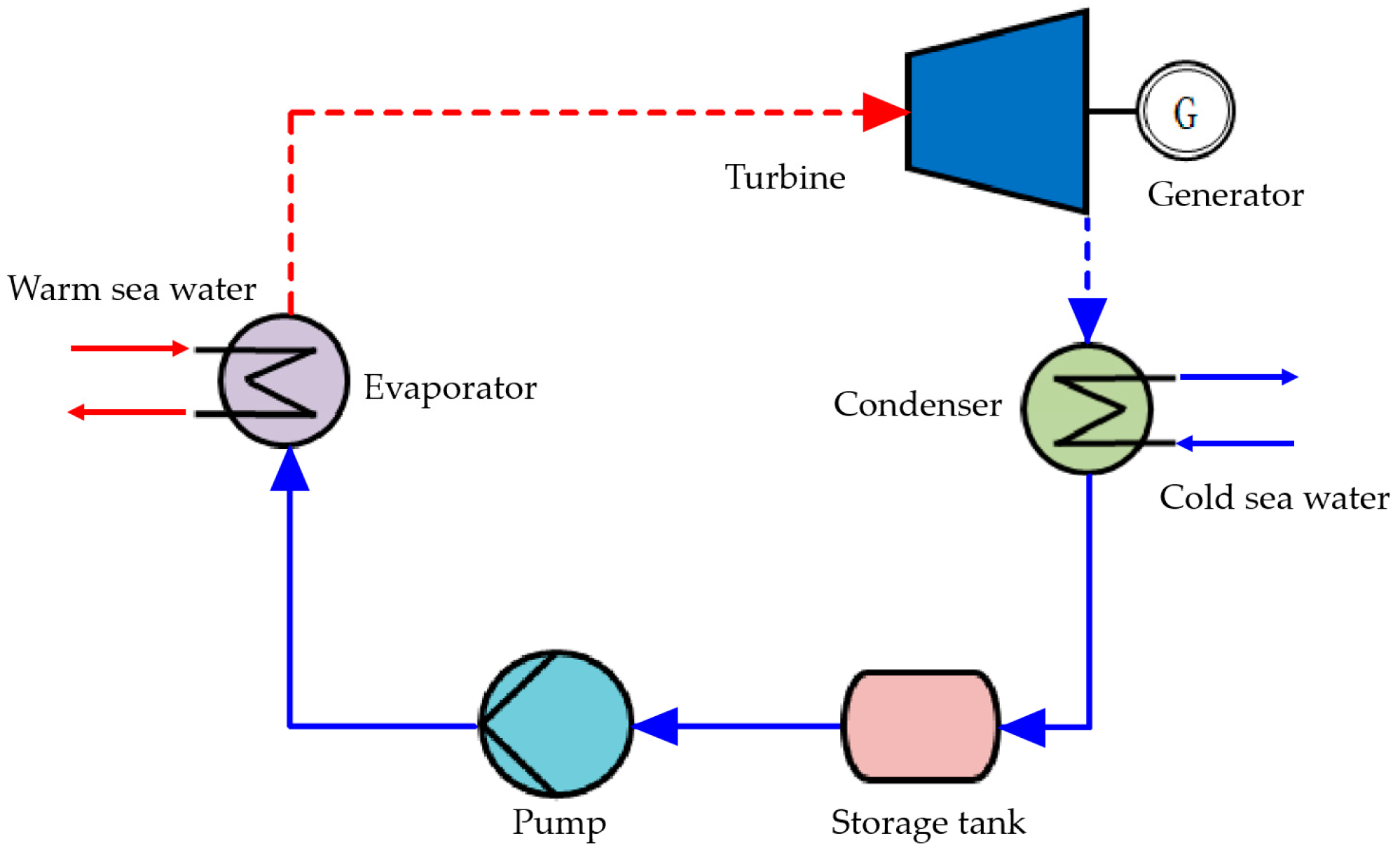


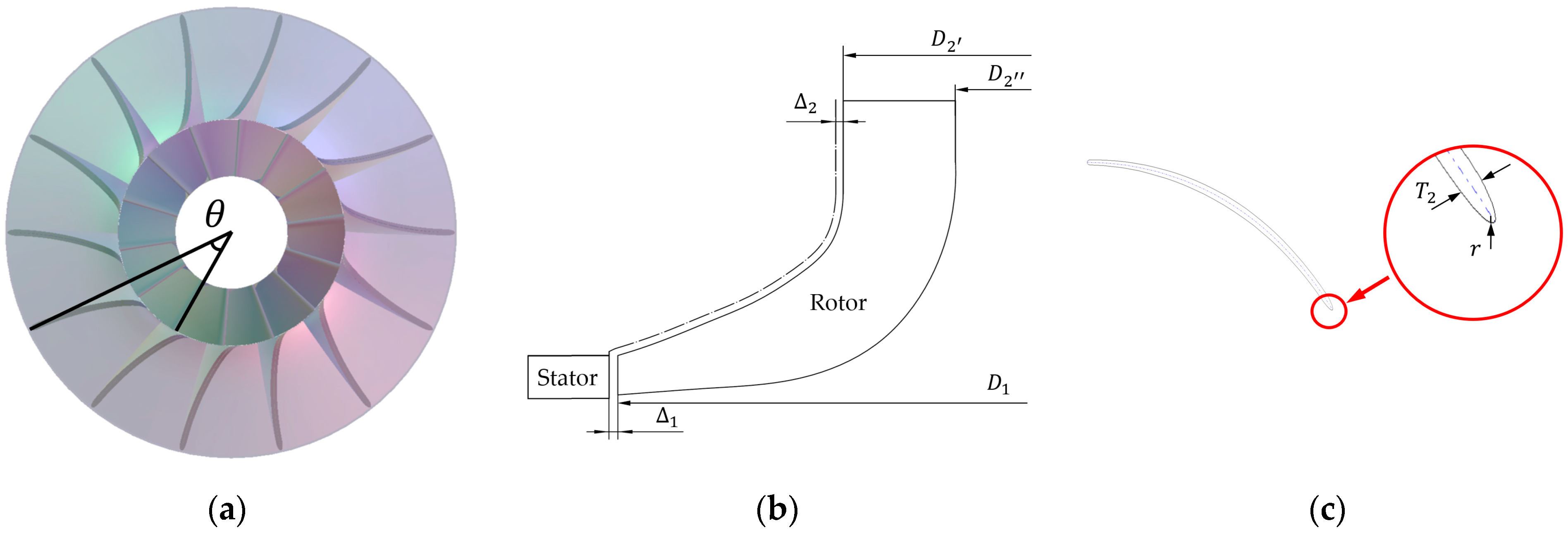
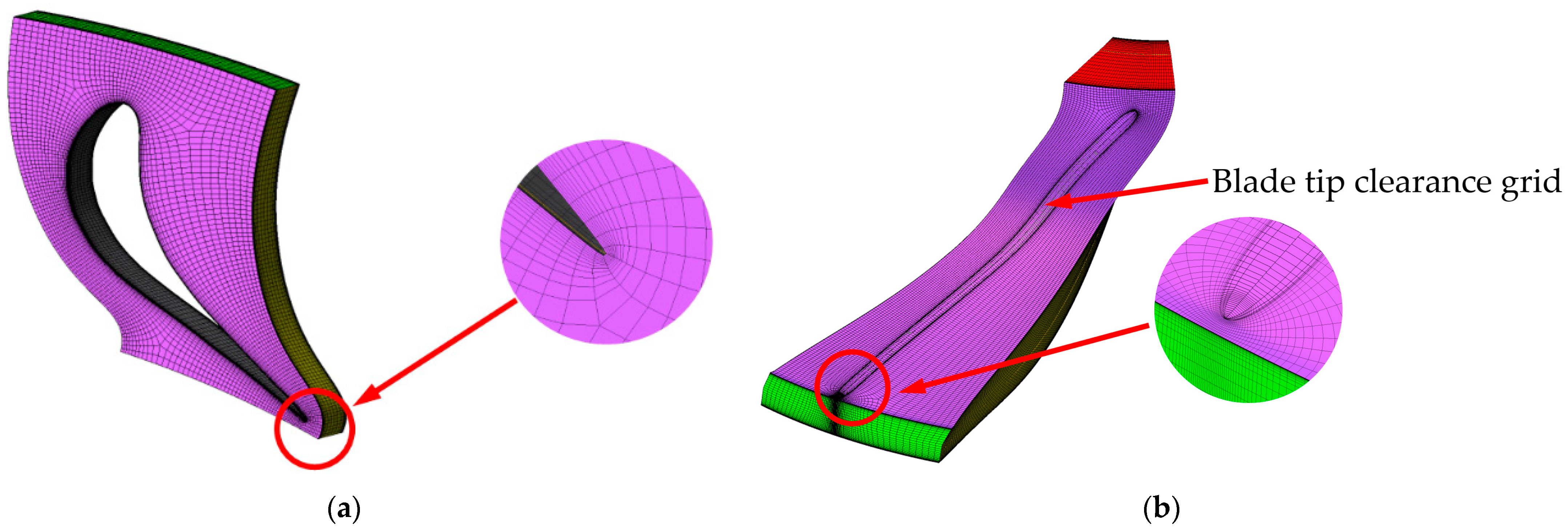

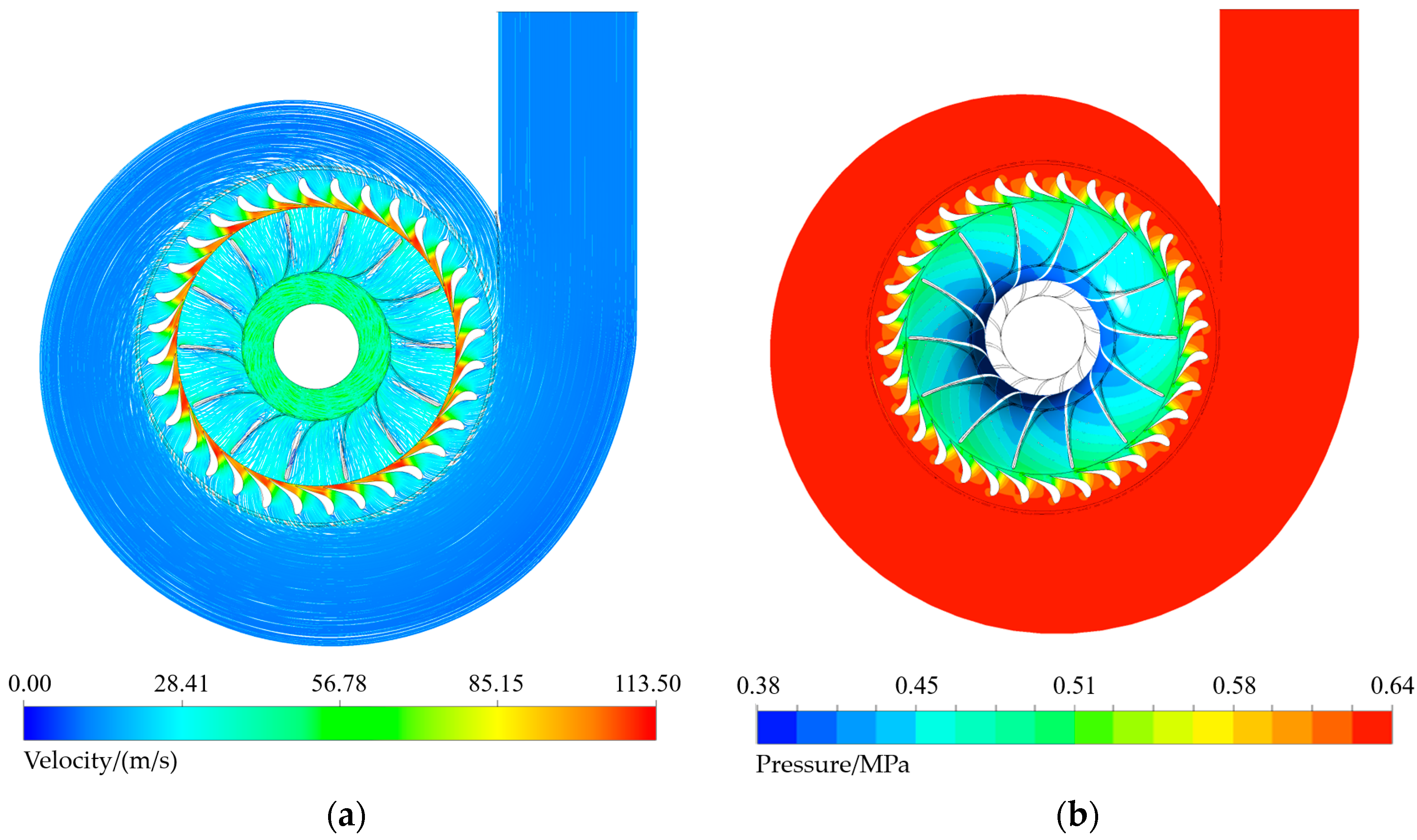
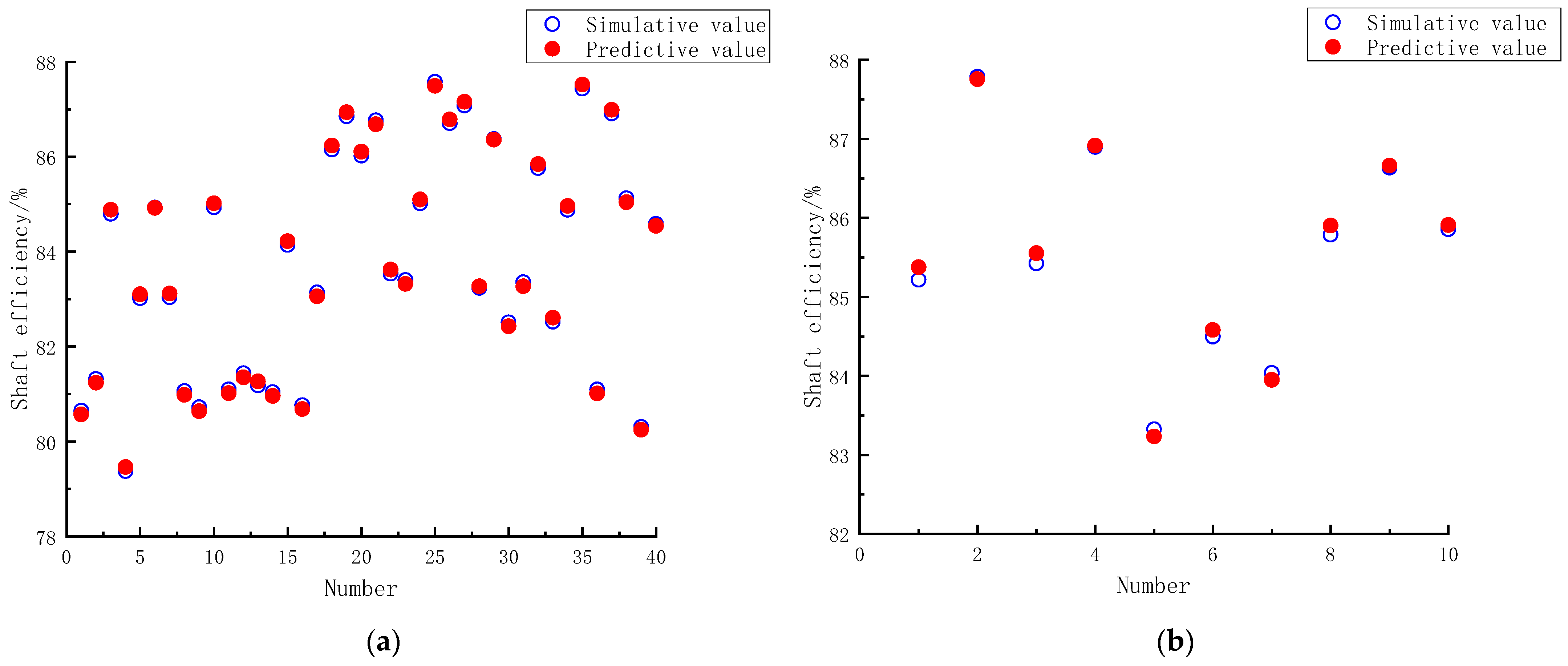

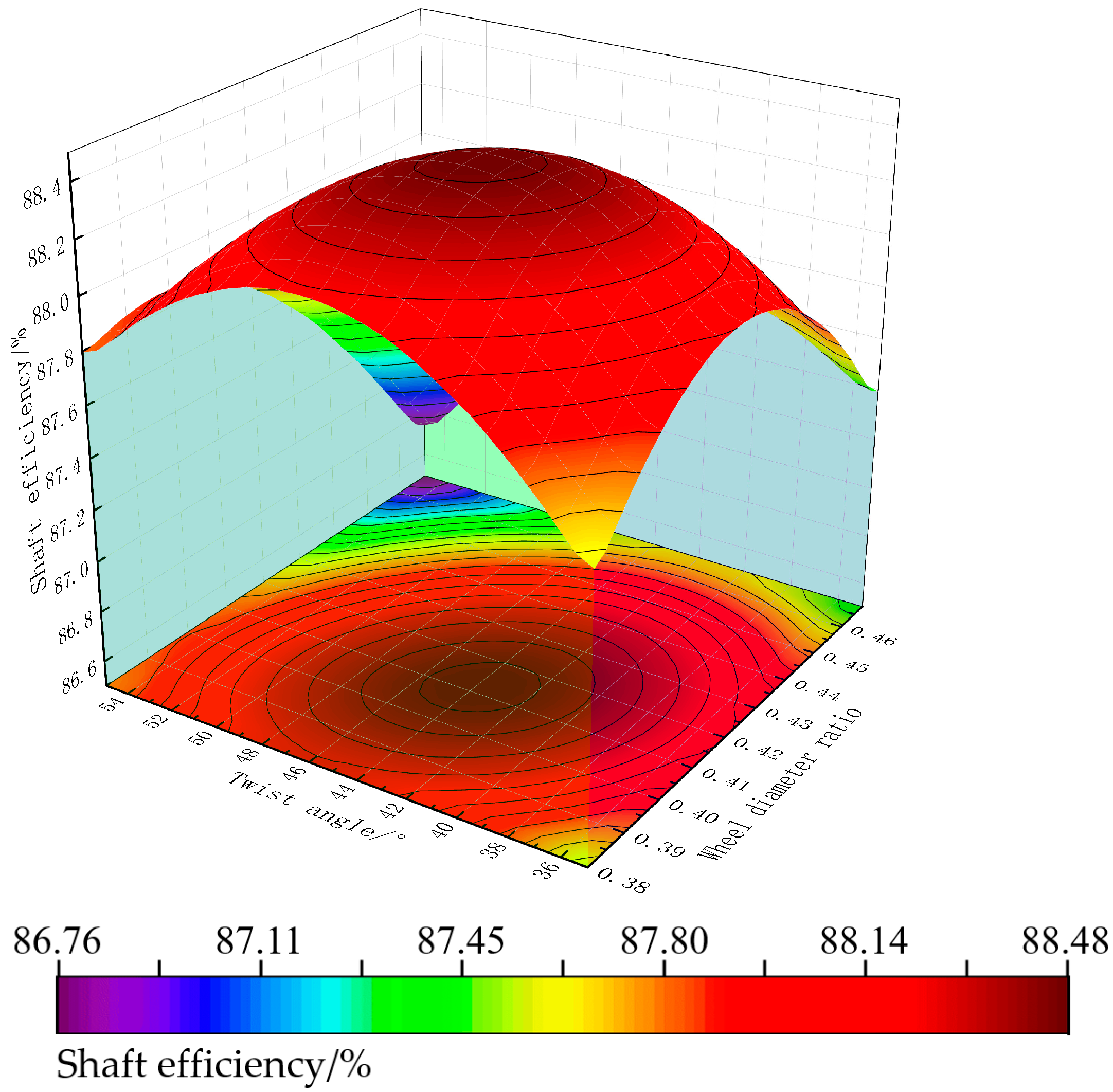

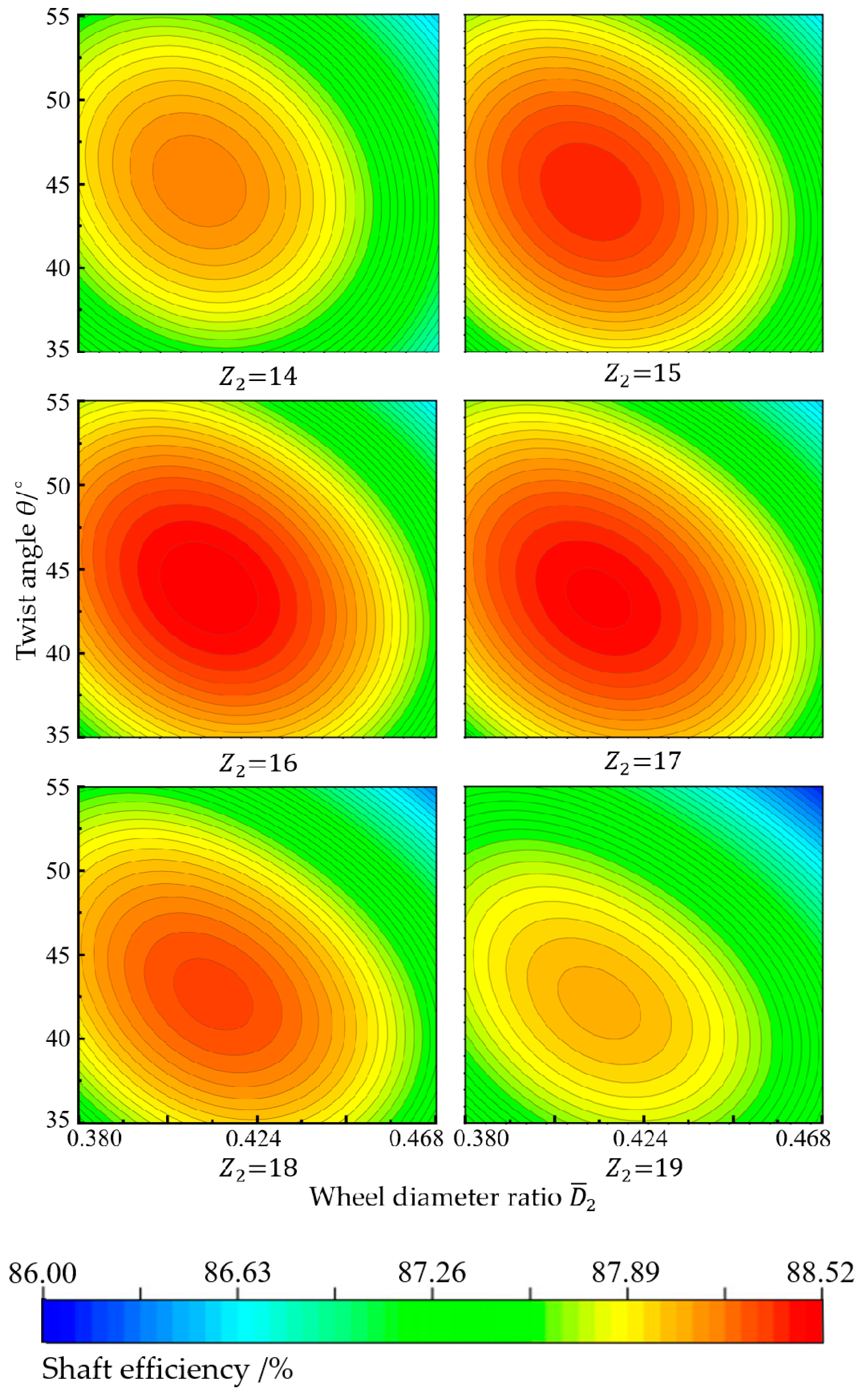
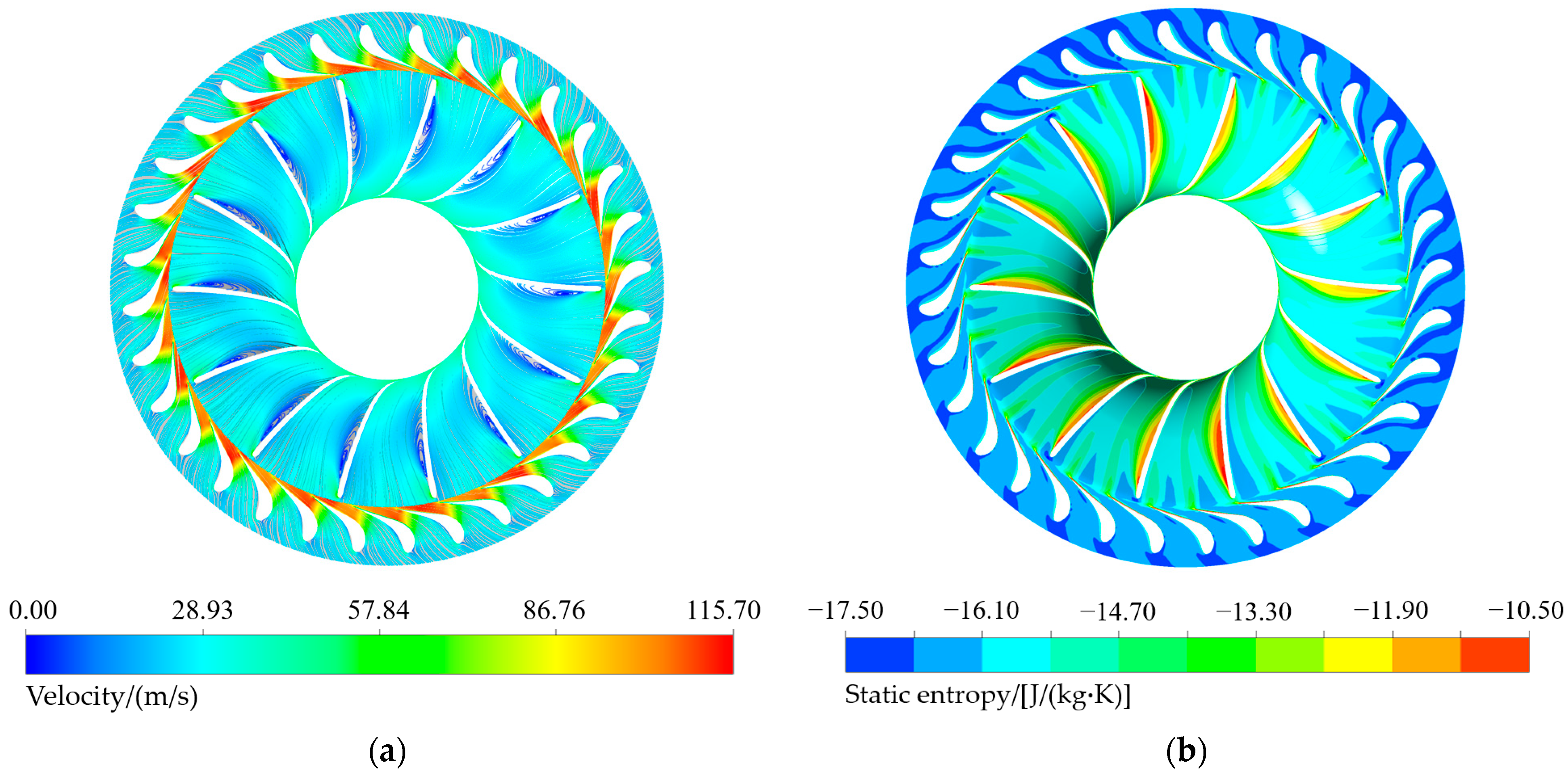
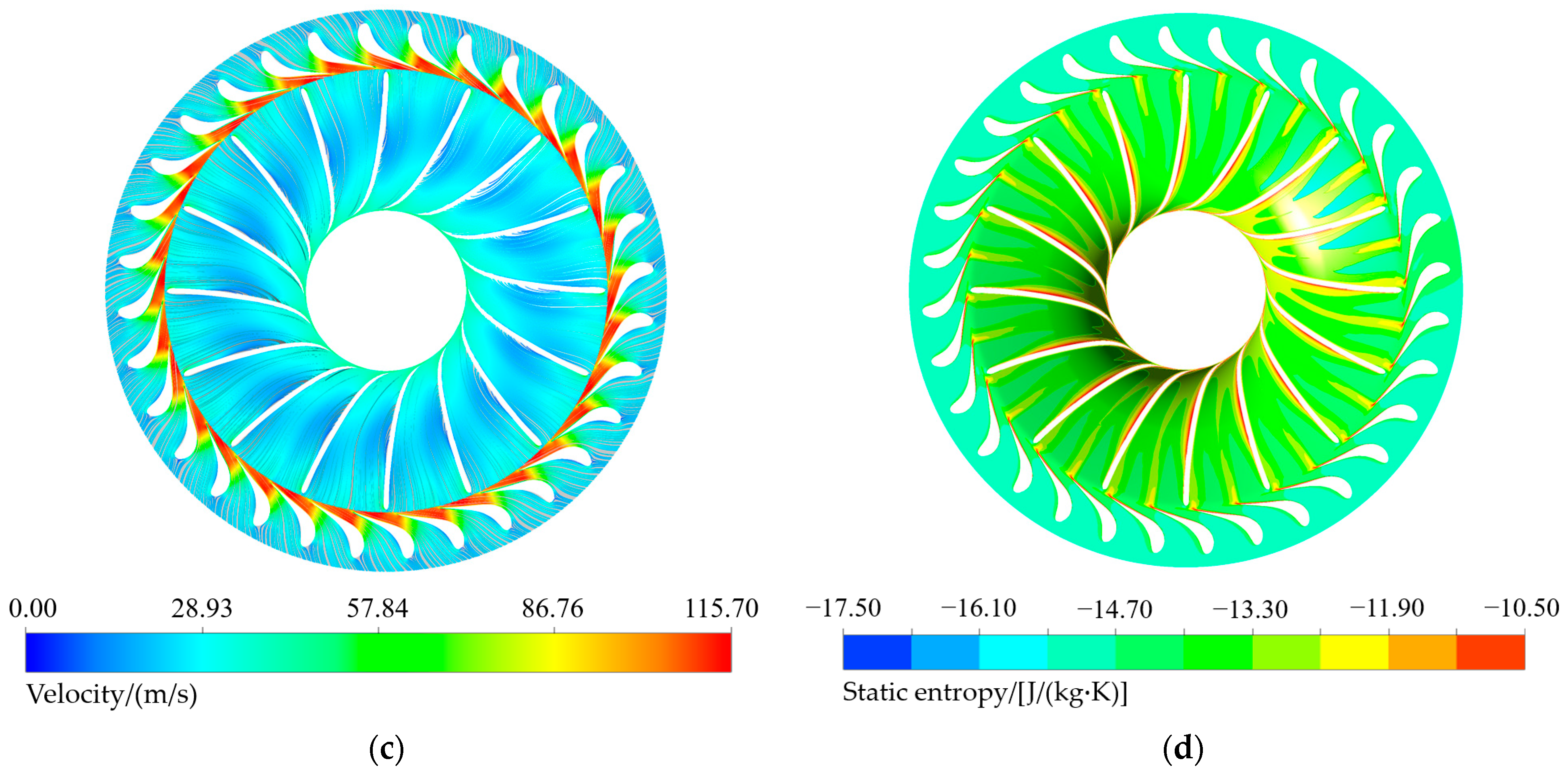
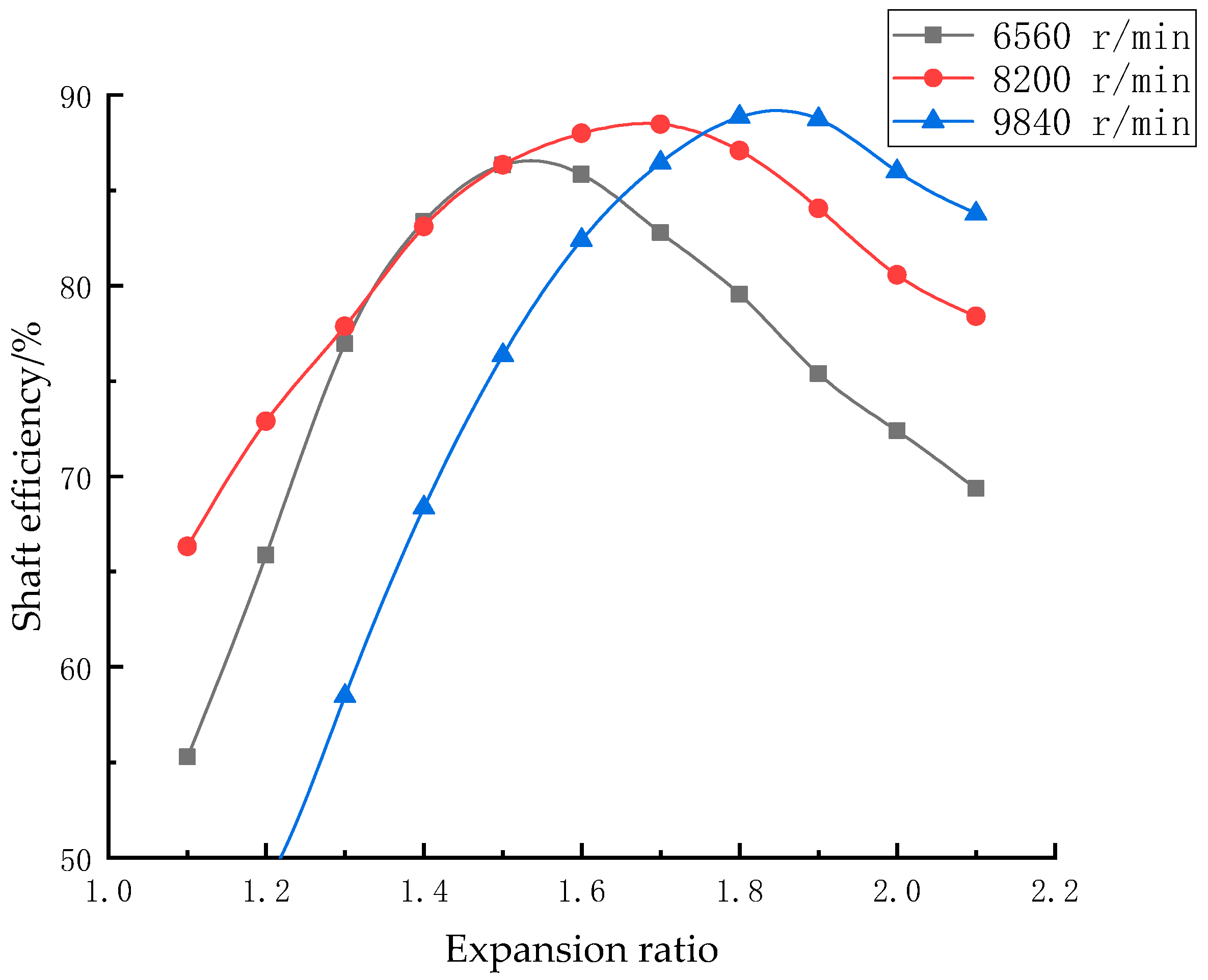
| Thermal Parameters | Results |
|---|---|
| Inlet total pressure /MPa | 0.64 |
| Inlet total temperature /K | 297.15 |
| Outlet static pressure /MPa | 0.393 |
| Mass flow rate /(kg/s) | 3.684 |
| Isentropic efficiency /% | ≥85 |
| Rotational speed (r/min) | ≤15,000 |
| Generated power /kW | 30 |
| Parameter | Design Value |
|---|---|
| Reaction degree | 0.479 |
| Wheel–diameter ratio | 0.443 |
| Speed ratio | 0.65 |
| Stator speed coefficient | 0.96 |
| Rotor speed coefficient | 0.85 |
| Rotor inlet absolute airflow angle /° | 16.0 |
| Rotor outlet relative airflow angle /° | 37.2 |
| Rotor inlet relative airflow angle /° | 85.19 |
| Rotor inlet circumferential speed /(m/s) | 93.17 |
| Rotor inlet absolute speed /(m/s) | 99.32 |
| Rotor inlet relative speed /(m/s) | 27.47 |
| Rotor outlet absolute airflow angle /° | 86.58 |
| Rotor outlet circumferential speed /(m/s) | 37.27 |
| Rotor outlet absolute speed /(m/s) | 29.46 |
| Rotor outlet relative speed /(m/s) | 48.86 |
| Rotor blade twist angle /° | 45.35 |
| Height of stator inlet /mm | 8.601 |
| Rotor inlet diameter /mm | 217 |
| Rotor outlet outer diameter /mm | 110.83 |
| Rotor outlet inner diameter /mm | 52.78 |
| Radial clearance /mm | 2.52 |
| Blade tip clearance /mm | 0.43 |
| Rotor outlet blade thickness /mm | 2.35 |
| Rotor outlet blade fillet radius /mm | 4.54 |
| Isentropic expansion efficiency /% | 88.169 |
| Shaft efficiency /% | 86.228 |
| Rotor speed /(r/min) | 8200 |
| Number of stator blades | 32 |
| Number of rotor blades | 14 |
| Diameter of stator outlet /mm | 219 |
| Rotor axial length | 65.1 |
| Parameters | Value |
|---|---|
| 0.38~0.468 | |
| 12~20 | |
| 35°~55° | |
| 2~3 mm | |
| 0.15~1.5 mm | |
| 1~3 mm | |
| 0.1~5 mm |
| Parameters | Values |
|---|---|
| 0.421 | |
| 16 | |
| 43.378 | |
| 2.553 | |
| 0.273 | |
| 1.582 | |
| 3.152 |
Disclaimer/Publisher’s Note: The statements, opinions and data contained in all publications are solely those of the individual author(s) and contributor(s) and not of MDPI and/or the editor(s). MDPI and/or the editor(s) disclaim responsibility for any injury to people or property resulting from any ideas, methods, instructions or products referred to in the content. |
© 2023 by the authors. Licensee MDPI, Basel, Switzerland. This article is an open access article distributed under the terms and conditions of the Creative Commons Attribution (CC BY) license (https://creativecommons.org/licenses/by/4.0/).
Share and Cite
Wang, Y.; Chen, Y.; Xue, G.; Zhang, T.; Liu, Y. Parameter Optimization and Performance Research: Radial Inflow Turbine in Ocean Thermal Energy Conversion. J. Mar. Sci. Eng. 2023, 11, 2293. https://doi.org/10.3390/jmse11122293
Wang Y, Chen Y, Xue G, Zhang T, Liu Y. Parameter Optimization and Performance Research: Radial Inflow Turbine in Ocean Thermal Energy Conversion. Journal of Marine Science and Engineering. 2023; 11(12):2293. https://doi.org/10.3390/jmse11122293
Chicago/Turabian StyleWang, Yiming, Yun Chen, Gang Xue, Tianxu Zhang, and Yanjun Liu. 2023. "Parameter Optimization and Performance Research: Radial Inflow Turbine in Ocean Thermal Energy Conversion" Journal of Marine Science and Engineering 11, no. 12: 2293. https://doi.org/10.3390/jmse11122293





